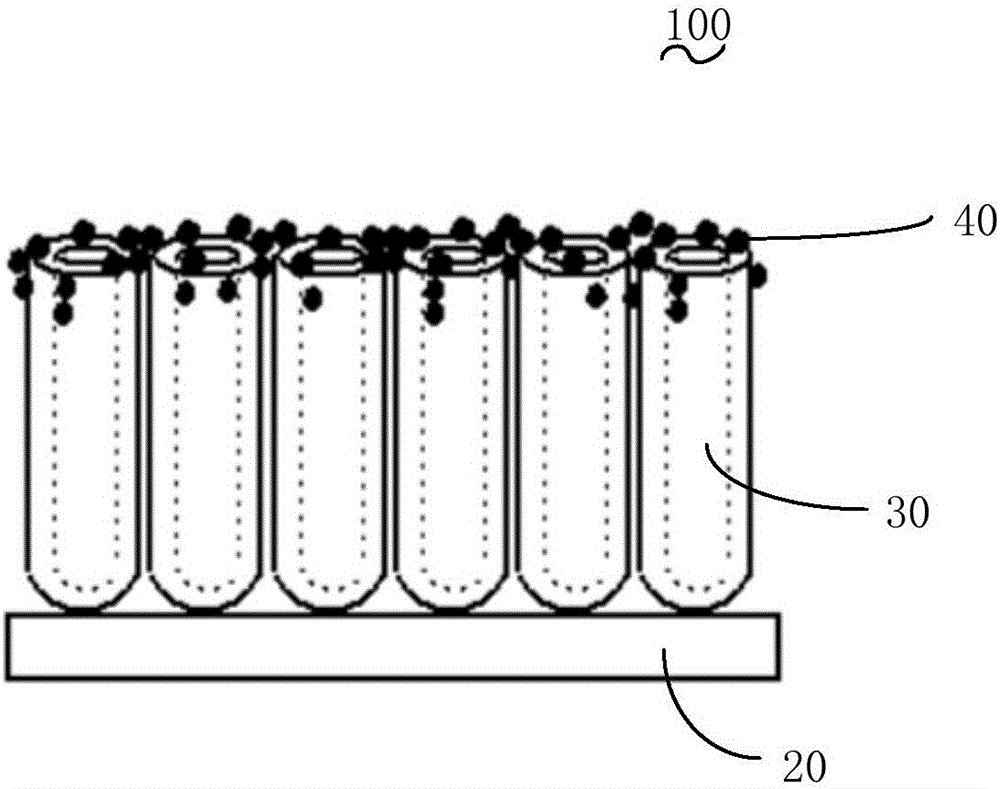TiO2-based nano heterojunction compound light anode and preparation method thereof
A heterojunction and composite light technology, applied in the field of solar cells, can solve the problems of restricting practical application, low utilization rate of visible light, low quantum efficiency, etc., and achieve the effect of expanding absorption band edge, suppressing recombination, and high visible light absorption efficiency.
- Summary
- Abstract
- Description
- Claims
- Application Information
AI Technical Summary
Problems solved by technology
Method used
Image
Examples
preparation example Construction
[0036] The embodiment of the present invention also discloses a TiO-based 2 The preparation method of the nano-heterojunction composite photoanode, comprises the following steps:
[0037] S1: Provide a transparent conductive substrate.
[0038] In the embodiment of the present invention, the transparent conductive substrate is AZO transparent conductive glass. The AZO transparent conductive substrate is cleaned and dried for later use.
[0039] S2: preparing a titanium alloy thin film on the transparent conductive substrate.
[0040] In the embodiment of the present invention, a titanium alloy thin film is prepared on the transparent conductive substrate by using a magnetron sputtering method. Specifically, the magnetron sputtering parameters are: radio frequency magnetron sputtering, sputtering power 50-150W, sputtering current 0.4-0.8A, sputtering time 0.3-3h, sputtering atmosphere is argon, air pressure It is 0.4-0.8Pa.
[0041] In the embodiment of the present inventi...
Embodiment 1
[0061] Based on TiO in embodiment 1 2 The preparation method of the nano-heterojunction composite photoanode, comprises the following steps:
[0062] S1: A sheet of AZO transparent conductive glass is provided, and the sheet of AZO transparent conductive glass is cleaned and dried for later use.
[0063] S2: Prepare a copper-titanium alloy thin film on the transparent conductive substrate by magnetron sputtering. The magnetron sputtering parameters are as follows: radio frequency magnetron sputtering, sputtering power of 80W, sputtering current of 0.6A, sputtering time of 2h, sputtering atmosphere of argon, and pressure of 0.6Pa.
[0064] S3: Anodize the transparent conductive substrate with the copper-titanium alloy film by anodic oxidation method, the composition of the anodized organic solvent electrolyte is: ethylene glycol solvent and NH with a concentration of 0.2mol / L 4 F, concentration is the lactic acid of 0.15mol / L and the volume fraction is the deionized water of ...
Embodiment 2
[0068] Based on TiO in embodiment 2 2 The preparation method of the nano-heterojunction composite photoanode is the same as that in Example 1 based on TiO 2 The preparation method of the nano-heterojunction composite photoanode is roughly the same, the difference is that in the step S4 in the embodiment 2, a hydrogen atmosphere is used to treat the TiO 2 The precursor of the nanotube array thin film is annealed and crystallized, and the rest of the steps are the same as in Example 1.
[0069] Embodiment 2 obtains based on TiO 2 Nano-heterojunction composite photoanode, in which TiO 2 Nanotube array films have Cu-doped phases and oxygen vacancies.
PUM
| Property | Measurement | Unit |
|---|---|---|
| size | aaaaa | aaaaa |
Abstract
Description
Claims
Application Information
 Login to View More
Login to View More - R&D
- Intellectual Property
- Life Sciences
- Materials
- Tech Scout
- Unparalleled Data Quality
- Higher Quality Content
- 60% Fewer Hallucinations
Browse by: Latest US Patents, China's latest patents, Technical Efficacy Thesaurus, Application Domain, Technology Topic, Popular Technical Reports.
© 2025 PatSnap. All rights reserved.Legal|Privacy policy|Modern Slavery Act Transparency Statement|Sitemap|About US| Contact US: help@patsnap.com

